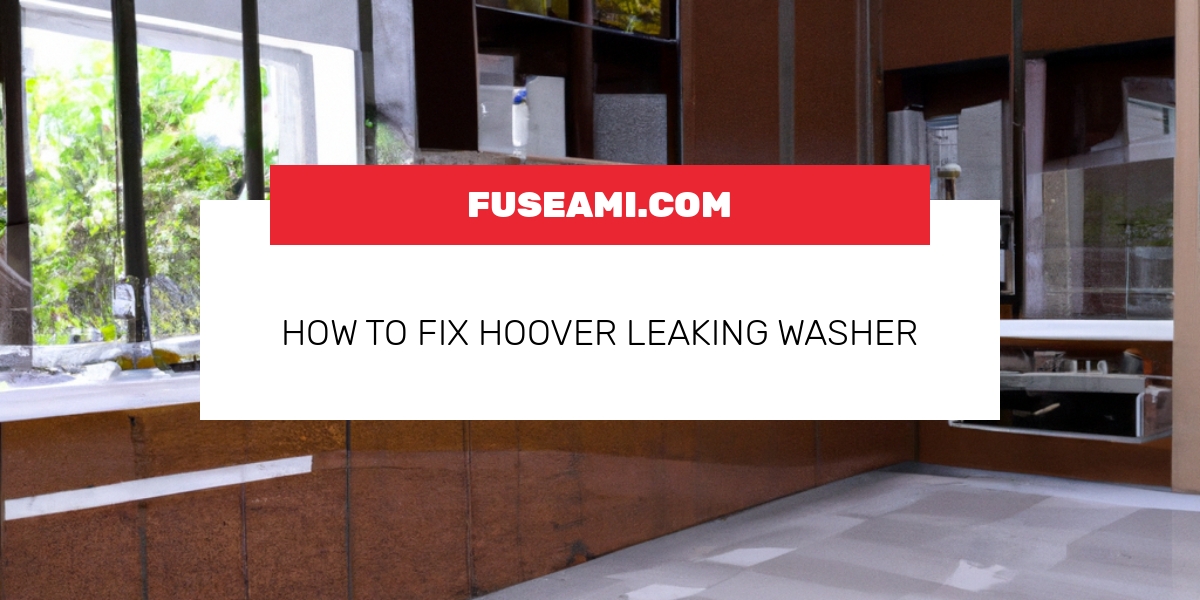Although a leaking Hoover washing-machine can be frustrating and costly to fix but it is typically solved with a bit of information and a few tools. This article will explain the most frequently cited reasons for leaks from a Hoover washing machine and will provide step-by step instructions for fixing it.
We’ve got you covered, no matter if you are experiencing a small leak or major flooding. With the right approach it’s possible to fix leaky washers and get back to doing your laundry in the shortest amount of time. Hoses: If your washing machine is leaky, it is best to examine the hoses. There are many types of hoses on the Hoover washing machine.
The most common are the drain and fill hoses. How do you inspect the hoses that are on your Hoover washing machine:
- To ensure that they are tightly securing, check connections in the back. In the next step, check to see if there is no obstruction to the drain.
- To check the internal hoses inside the washer, disconnect the power supply, then take off the cabinet.
- Many internal hoses are connected to the tub. Inspect the hoses for any signs of cracks, abrasions or any other damages.
- If you discover a damaged hose(s), you will require Hoover replacement hose(s).
Pump
A water pump, or drain pump is a component of a Hoover washer that drains the water from the tub. It can be belt driven direct drive, belt driven, or even an electric pump. How to inspect the pump of your Hoover washing machine’s pumps:
- Disconnect your Hoover washing appliance from the power source before you begin.
- Remove the cabinet or front panel of your appliance and locate your pump(s).
- The pump is likely to include an outlet or drain hose and an inlet for the tub and possibly a circulating hose outlet as well. If water has started to leak out of the Hoover washer during a wash or drain cycle, inspect the location of the drain pump. First, check for loose hose clamps, or leaky hoses attached to the pump. If the leak is coming from the pump, you’ll need an exchange Hoover pump
Tub Cover Gasket:
The tub cover gasket on front and top load Hoover washers is used to provide a seal between the tub’s outer and tub cover. If you are experiencing water leaks during the spin or wash parts of the cycle then the tub cover gasket may be the source of the issue. How to check the tub cover gasket of a Hoover washing machine:
- Unplug the Hoover washer, then remove the front or cabinet.
- Locate the gasket for the tub cover. In order to access the tub cover, you’ll likely need to pull off the cover.
- You must examine the gasket for wear and damage. Additionally, check out for water stains or water leaks from this location to diagnose the problem.
- If the gasket in your tub is worn or damaged, or if there are indications of leakage in the area You will require a Hoover replacement gasket for the tub cover.
Water Inlet Valve:
This valve controls the flow of cold and hot water into the Hoover washing machines. How do you inspect your Hoover washing machine’s water intake valve:
- Before starting, disconnect the water and power sources from the washing machine.
- Remove the panel on the back of your machine and identify the water inlet valve. It is likely to be behind the hose connections.
- Remove the valve from the washer and examine the screens for any debris or buildups. Be careful when doing this as the screens cannot be replaced and if they are damaged, you’ll need to replace the entire valve. You should also inspect the valve for any signs of wear, cracks, or damage.
- Using a multi-meter on Rx1 mode, place probes over the terminals of the valve. You should get a different reading based on the model. Consult your manual to figure out what the recommended reading is for a functional valve.
- If you have a reading outside the range of recommended, if you read infinity, or if your valve is visibly damaged, you will need a Hoover replacement water inlet valve.
Bellows or Door Boot Seals:
The bellows for the door or door boot seal is used for front load washers by Hoover to seal between the door and the outer tub. Normal wear and tear could cause the bellows’ rubber to break, while foreign objects can cut or tear the bellows and cause an opening in the top of the Hoover washer. If your washer appears to be leaking in the door, it is possible that the bellows may be the cause.
- Disconnect the Hoover washer’s source of power.
- Inspect the door for any damage, dirt or detergent buildup. Be aware of sharp foreign objects that can cause tears, are frequently hidden in the folds of the bellows. They could be a hazard.
- If you observe any of the symptoms listed above then you’ll need Hoover replacement bellows.
Water Level Switch, Pressure Switch & Air Dome Tub
The leaky Hoover washer could be the result of overfilling. The water level switch activated through pressure serves to regulate the level of water within the tub. As the water fills in the tub, it will compress the air inside the tube, pushing against a diaphragm inside the switch. The valve for water inlet will be controlled by the switch, which will turn off the valve at the correct water level. Here’s how you can check the water level switch in your Hoover washer:
- If you’re going to work with electrical components, make sure you have turned off the washer’s power.
- Locate and take out the water level switch. The water level switch is normally found behind the control panel. It will be attached to the tub using an air dome tube. On Hoover washers that have an electronic control, this switch may be found in the bottom of the sump beneath the tub.
- To find out whether the switch has a problem You must first remove the air dome hose to determine if it is a problem. Check for evidence of wear or cracks in the hose. Take the hose off and immerse the hose in water. Cover one end with a seal and blow air through the other, and then look for bubbles. Also, look for any obstructions in the hose.
- If the air dome hose seems to be in good condition, then it is possible that you need a Hoover replacement water level switch.
Door Catch Door Catch:
The door catch of a front load Hoover washer machine is responsible for keeping the door closed tightly during the cycle. The door locking mechanism will lock the door catch or hook and stop the door from being opened during the cycle. The door catch might wear out, but will be able to lock the door. What to look for in the door catch on a Hoover washing machine’s door catch:
- Depending on the model you may have to remove the front panel to access the door catch properly for you to check it. If not, just remove the screws that secure it. To access the front panel, you will need to unplug it before you begin.
- Take a look at the door’s catch for any cracks, discoloration, wear, damage, or any foreign objects that might make it difficult to close properly.
- If you notice any indications of wear or damage you’ll require a Hoover replacement door catch.
Tub Seal or Boot Sea
l Tub Seal or Boot Seal used on a Hoover washing machine to keep water from flowing between the shaft of the basket and transmission shaft. A damaged seal could cause the main tub bearing to break. It could begin as a small water leak. If your washer is leaking during the fill or agitation phase of the cycle, then it could be the tub seal has been damaged and must be replaced. How do you inspect the tub seal of a Hoover washing machine:
- To verify whether the tub seal is the cause of your leak, remove the front panel of the washing machine and allow the machine to fill up with water as normal. Check the area where the transmission shaft enters the tub to look for indications of leaks of water.
- Rear access panels need to be removed from front load washers. Check for water leakage from the weep holes near the bearing case in the rear. If you spot any water leaking from the weep holes located near the housing housing for the rear bearing, it is time to get a new tub seal from Hoover.



